| In the future, tissue engineering may provide therapies to heal all kinds of injuries, including neural damage. This 3D animated view of the central nervous system shows a small fraction of neurons and glia cells, illustrating normal neural communication. |
 |
Regenerative Medicine: A Growing Future
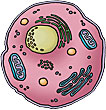 Reinforcing its role as a town square for science, Carnegie Science Center, in partnership with the field’s leading experts right here in Pittsburgh, is demystifying the fascinating science of tissue engineering. Reinforcing its role as a town square for science, Carnegie Science Center, in partnership with the field’s leading experts right here in Pittsburgh, is demystifying the fascinating science of tissue engineering.
By Jennifer Bails
As a U.S. Army squad leader during Operation Iraqi Freedom, Staff Sgt. Shilo Harris led dozens of scouting missions to hunt for roadside bombs in southern Baghdad. On Feb. 19, 2007, a deadly explosion rocked his convoy, killing three soldiers and burning Harris over more than 30 percent of his body. The young father from Texas also lost both ears and three fingers in the attack.
Unfortunately, unlike the lowly salamander and starfish, wounded soldiers cannot regenerate body parts when they are severely injured or amputated. Instead, scar tissue forms, which doesn’t function or feel like healthy tissue. But that’s not the case in the womb, where a human fetus can grow new body parts until about four months’ gestation. The challenge for scientists is how to replicate this almost magical process.
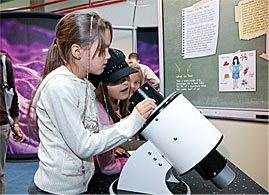 Stephen Francis Badylak, a physician and deputy director of the McGowan Institute for Regenerative Medicine, a joint effort of the University of Pittsburgh and University of Pittsburgh Medical Center, has pioneered such a process using a natural substance called extracellular matrix to essentially trick cells into behaving as if they were in utero again. Stephen Francis Badylak, a physician and deputy director of the McGowan Institute for Regenerative Medicine, a joint effort of the University of Pittsburgh and University of Pittsburgh Medical Center, has pioneered such a process using a natural substance called extracellular matrix to essentially trick cells into behaving as if they were in utero again.
The new Starfish exhibit makes science fun by breaking down complex lessons into less-intimidating but still informative games
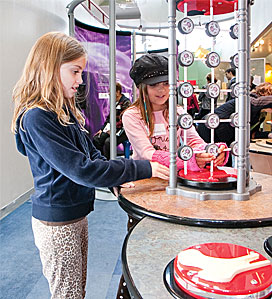
Extracellular matrix is largely a mix of calcium and other minerals and the protein collagen. Although it was long thought to be just the glue holding cells together, scientists now believe this material contains a multitude of molecules that release signals that recruit stem cells to an injury for repair.
Regenerating lost limbs might sound more like the stuff of science fiction than of science. Indeed, Badylak shocked even the medical world when Harris and a second patient re-grew their severed fingertips by about a half-inch in six weeks using a powder derived from extracellular matrix in pig bladders.
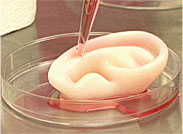 “This makes a tremendous difference in their lives,” says Badylak during an “Ask the Scientist” video in the new exhibit, If a Starfish Can Grow a New Arm, Why Can’t I?, which opened this past October at Carnegie Science Center. “This makes a tremendous difference in their lives,” says Badylak during an “Ask the Scientist” video in the new exhibit, If a Starfish Can Grow a New Arm, Why Can’t I?, which opened this past October at Carnegie Science Center.
Scientists seed an ear scaffold with cells
to engineer a human ear in the laboratory
This salamander shows off an extra arm grown from
its natural left arm as part of an experimental procedure.
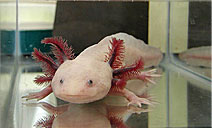
From better skin grafts for burn victims to replacement body parts grown in laboratories, Science Center visitors are learning how the emerging fields of regenerative medicine and tissue engineering are soon going to make a profound difference in all of our lives. They also are discovering how scientists in Pittsburgh are at the forefront of this interdisciplinary research that seeks ways to induce the body to repair itself—or develop substitute tissues and organs for transplantation—as cures for virtually every known disease.
“We can’t give all children the opportunity to poke at live cells, but we can put them in a virtual world and have them do some of the same experimental things they might do in a laboratory.”
- John Archie Pollock, associate professor of biological sciences at Duquesne University and science filmmaker
So far, researchers have bioengineered ears, beating hearts, and bladders by manipulating cells into re-growing tissue. The possibilities are endless, says Alan Russell, director of the McGowan Institute, a partner in developing the Starfish exhibit.
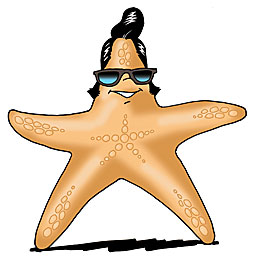 “The kind of work that we do is incredibly exciting to people when they understand it, but it can be hard to explain and sometimes it seems surprising,” says Russell, also executive director of the Pittsburgh Tissue Engineering Initiative (PTEI), a nonprofit group aiming to establish Pittsburgh as a hub for regenerative medicine research and technology development. “The kind of work that we do is incredibly exciting to people when they understand it, but it can be hard to explain and sometimes it seems surprising,” says Russell, also executive director of the Pittsburgh Tissue Engineering Initiative (PTEI), a nonprofit group aiming to establish Pittsburgh as a hub for regenerative medicine research and technology development.
As part of that mission, it is “critically important” to reach out to the public to strip away the mystery—and misconceptions—from this 21st-century approach to biomedicine, Russell says.
Another part of that mission, says Ann Metzger, co-director of Carnegie Science Center, is to help create the medical scientists of the future. “There are more than 1,000 unfilled positions in research and technology in the region at any given time, and we think public programming like the Starfish exhibit will inspire some children to explore science and medical careers.”
Tween tested
The Starfish exhibit is the first of its kind and was a decade in the making. The Science Center’s first foray into the topic of tissue regeneration was its popular series of planetarium shows for its Buhl Digital Dome called Tissue Engineering For Life. The series marked the world’s first planetarium shows investigating the science of growing molecules, cells, tissues, and organs to replace defective or injured ones.
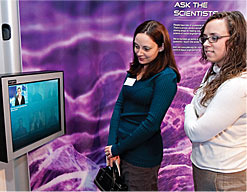 Joan Schanck, director of education and workforce development at PTEI, was the visionary behind a permanent Science Center exhibit that would also present the basic science of regenerative medicine and tissue engineering, along with real-world perspectives and applications. Her primary goal was to empower visitors to understand what is possible today in these fields and what the future may hold. Joan Schanck, director of education and workforce development at PTEI, was the visionary behind a permanent Science Center exhibit that would also present the basic science of regenerative medicine and tissue engineering, along with real-world perspectives and applications. Her primary goal was to empower visitors to understand what is possible today in these fields and what the future may hold.
“It was ecstasy as a teacher to hear an idea that huge coming from a third grader.”
- Bernie Bileck, a science teacher at Providence Heights Alpha School
“Any committed, responsible scientist also understands and appreciates the imperative to communicate their findings, especially to the next generation,” Schanck says. “Whether children go on to become scientists doesn’t matter as long as they become scientifically literate consumers who can make healthy choices.”
A $10,000 grant from The Pittsburgh Foundation jump-started the project, enabling Schanck to do a feasibility study that considered what an exhibit might look like. Then PTEI, Carnegie Science Center, ASSET Inc., McGowan Institute, and the University of Pittsburgh Learning Research and Development Center officially formed a partnership with the goal of turning concepts into reality.
In 2007, the group received a five-year, $1.25 million Science Education Partnership Award from the National Center for Research Resources of the National Institutes of Health to develop Starfish, which is on display in the first-floor Science Center Atrium for the next three to five years. And while the inquiry-based attraction has been a hit with all ages, the target audience is middle school students in grades six through eight.
“Middle school is a critical point in solidifying children’s interest in science,” Schanck explains. “Our exhibit reinforces major concepts that map directly to the state and national science standards for that age group, such as cell structure and division, and it also shows the students why it is important to learn all this stuff.”
But translating the complex, ever-evolving science of regenerative medicine into an interactive museum experience that’s both engaging and accessible to tweens was a challenge, says Ron Baillie, Carnegie Science Center co-director.
In-house educators and exhibit designers had to balance which ideas the researchers believed were vital to include with the topics children found most exciting and those lessons that reinforced concepts teachers were introducing in the classroom. Pitt’s Learning Research and Development Center continues to lend evaluation expertise to ensure that the project meets its educational goals.
The result, Baillie says, is a gallery space where visitors tend to spend more time than usual to gather and process all of the information presented. “It’s a more contemplative atmosphere compared to the usual hustle-and-bustle of the Science Center,” he says. “People are definitely getting the key messages.”
Breaking it down
One key message is that, unlike humans, some less complex animals such as starfish can re-grow limbs and other major body parts after an injury. This happens through the accumulation of a mass of progenitor cells—early descendants of stem cells that can only differentiate, or divide and evolve, and not renew—at the site of a wound. Understanding how this mass—called a blastema—forms and functions in these animals could help scientists enhance the human body’s ability to heal itself.
Young learners can race against time trying to link
blood vessels together without forming deadly clots.
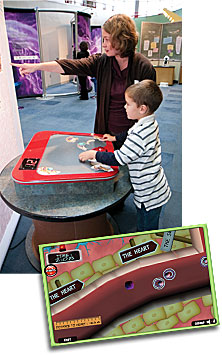 In the exhibit, visitors learn about the concept of progenitor cells by spinning a zoetrope (a Victorian-era moviemaking device) that houses slides of a newt, a semi-aquatic amphibian that looks like a cross between a lizard and a frog, re-growing a missing leg over a 32-day period. By looking through slots in the rotating drum, visitors can virtually watch cell regeneration in action. In the exhibit, visitors learn about the concept of progenitor cells by spinning a zoetrope (a Victorian-era moviemaking device) that houses slides of a newt, a semi-aquatic amphibian that looks like a cross between a lizard and a frog, re-growing a missing leg over a 32-day period. By looking through slots in the rotating drum, visitors can virtually watch cell regeneration in action.
To kickstart these repair processes within humans, scientists are learning how to unlock the secrets of stem cells—unspecialized cells that can self-replicate and give rise to the many different cells in our bodies. If researchers can control what kind of cell a stem cell ultimately becomes, then they can grow new nerves, repair sick hearts, and much more. At the Science Center, visitors can peer into a simulated microscope to watch an animated video introducing these much-talked-about cells with extraordinary therapeutic promise.
Stem cells, the exhibit explains, can be injected directly into the extracellular matrix of damaged tissue, or they can be seeded onto an artificial scaffold and allowed to grow in the lab prior to implantation in the body. In time, the stem cells multiply and replace the scaffold with healthy tissue. Healing depends on the growth of blood vessels to feed the new cells, a process known as angiogenesis.
At a multimedia kiosk, young learners solve a digital puzzle that challenges them to build this blood supply. The clock is ticking as players frantically try to link blood vessels together in a network without forming deadly clots. Grow With the Flow is one of three video games developed for Starfish under the leadership of John Archie Pollock, an associate professor of biological sciences at Duquesne University and science filmmaker.
“We can’t give all children the opportunity to poke at live cells, but we can put them in a virtual world and have them do some of the same experimental things they might do in a laboratory,” says Pollock, who also led the team that created the planetarium shows on tissue engineering. “Any time you can get children to do something themselves versus passively sitting back in the classroom, they are going to learn better.”
The Starfish exhibit shows students how doctors are putting all of this research to work to treat patients, and it invites people to give their opinions on sensitive ethical questions, particularly as they relate to stem cell therapies.
Stem cells, visitors learn, can be found not only in the embryo, but the umbilical cord, placenta, and in adults. Embryonic stem cells have the capacity to develop into a greater variety of tissues than other types, but their use has generated opposition from people with moral objections to the destruction of human embryos to obtain the cells.
“When many people think of regenerative medicine, they think of stem cells without understanding there are many different kinds,” Russell says. “Rather than just ignore the controversy, we decided to embrace it and educate people to the point they could make their decisions based on fact.”
A game-changer
“Tissue engineering and regenerative medicine are exciting and cutting-edge areas in science; however, these can be somewhat complicated topics for middle school teachers and students to explore,” says Deborah Spencer, program outreach manager at ASSET Inc.
ASSET is a South Side-based nonprofit dedicated to continuously improving teaching and learning through research- and standards-based teacher professional development and hands-on, inquiry-based science curriculum materials. Working with PTEI, the organization designed a two-day professional development course that helps teachers connect the science concepts presented in the exhibit to their own science curricula, building on concepts of molecular biology and tissue physiology already taught in middle school science courses. (The next one will be held June 9-10.) Teachers also have access to a free educators’ manual on Carnegie Science Center’s website.
Educating teachers about regenerative medicine and preparing them with effective strategies allows them to bring the wonders of this real-world science into their classrooms and to make a visit to the Starfish exhibit more meaningful, Spencer says. Already, 15 teachers have participated in this intensive course, including Bernie Bileck, a science teacher who brought his newfound knowledge and supporting curriculum materials back to his elementary school students at Providence Heights Alpha School, a private Catholic school in the North Hills.
“This experience was enlightening for me about how far medicine has come, and I cannot even put into words the impact this whole experience had on the children,” says Bileck, who plans to take his students to the Starfish exhibit this spring.
At the end of his lessons on tissue engineering, Bileck told his students that their bodies could regenerate in the womb and asked them if they thought it would be possible to regain that capacity. “They answered, ‘Yes, but we’d have to get the cells to communicate with each other,’” Bileck recounts. “I nearly fell over because that’s regenerative medicine in a nutshell. It was ecstasy as a teacher to hear an idea that huge coming from a third grader.”
Big in ambition, if not in size, the Starfish exhibit continues to spark curiosity at the Science Center. And it will soon have an even larger audience thanks to a traveling replica that will be installed at science centers in Miami, Orlando, Seattle, Birmingham, Ala., and Winston-Salem, N.C.
 “It’s a great story about the kind of innovation and research that is happening in Pittsburgh that will now go to five major cities and get our message out to hundreds of thousands of folks,” Baillie says. “It’s a great story about the kind of innovation and research that is happening in Pittsburgh that will now go to five major cities and get our message out to hundreds of thousands of folks,” Baillie says.
It’s a message of science—but also one of human ingenuity and hope for people like Staff Sgt. Shilo Harris. The extracellular matrix used to re-grow a portion of Harris’ finger is already offering promise for other therapies. Scientists are now studying different forms of the material as possible treatments for diseases of the heart, nervous system, esophagus, and liver that affect millions of patients.
“This is highly scientific work, but in the end it’s about making lives better,” Baillie says. “And that’s what is most exciting.”
|

 Stephen Francis Badylak, a physician and deputy director of the McGowan Institute for Regenerative Medicine, a joint effort of the University of Pittsburgh and University of Pittsburgh Medical Center, has pioneered such a process using a natural substance called extracellular matrix to essentially trick cells into behaving as if they were in utero again.
Stephen Francis Badylak, a physician and deputy director of the McGowan Institute for Regenerative Medicine, a joint effort of the University of Pittsburgh and University of Pittsburgh Medical Center, has pioneered such a process using a natural substance called extracellular matrix to essentially trick cells into behaving as if they were in utero again.
 “This makes a tremendous difference in their lives,” says Badylak during an “Ask the Scientist” video in the new exhibit, If a Starfish Can Grow a New Arm, Why Can’t I?, which opened this past October at Carnegie Science Center.
“This makes a tremendous difference in their lives,” says Badylak during an “Ask the Scientist” video in the new exhibit, If a Starfish Can Grow a New Arm, Why Can’t I?, which opened this past October at Carnegie Science Center. 

 Reinforcing its role as a town square for science, Carnegie Science Center, in partnership with the field’s leading experts right here in Pittsburgh, is demystifying the fascinating science of tissue engineering.
Reinforcing its role as a town square for science, Carnegie Science Center, in partnership with the field’s leading experts right here in Pittsburgh, is demystifying the fascinating science of tissue engineering.
 “The kind of work that we do is incredibly exciting to people when they understand it, but it can be hard to explain and sometimes it seems surprising,” says Russell, also executive director of the Pittsburgh Tissue Engineering Initiative (PTEI), a nonprofit group aiming to establish Pittsburgh as a hub for regenerative medicine research and technology development.
“The kind of work that we do is incredibly exciting to people when they understand it, but it can be hard to explain and sometimes it seems surprising,” says Russell, also executive director of the Pittsburgh Tissue Engineering Initiative (PTEI), a nonprofit group aiming to establish Pittsburgh as a hub for regenerative medicine research and technology development.  Joan Schanck, director of education and workforce development at PTEI, was the visionary behind a permanent Science Center exhibit that would also present the basic science of regenerative medicine and tissue engineering, along with real-world perspectives and applications. Her primary goal was to empower visitors to understand what is possible today in these fields and what the future may hold.
Joan Schanck, director of education and workforce development at PTEI, was the visionary behind a permanent Science Center exhibit that would also present the basic science of regenerative medicine and tissue engineering, along with real-world perspectives and applications. Her primary goal was to empower visitors to understand what is possible today in these fields and what the future may hold. In the exhibit, visitors learn about the concept of progenitor cells by spinning a zoetrope (a Victorian-era moviemaking device) that houses slides of a newt, a semi-aquatic amphibian that looks like a cross between a lizard and a frog, re-growing a missing leg over a 32-day period. By looking through slots in the rotating drum, visitors can virtually watch cell regeneration in action.
In the exhibit, visitors learn about the concept of progenitor cells by spinning a zoetrope (a Victorian-era moviemaking device) that houses slides of a newt, a semi-aquatic amphibian that looks like a cross between a lizard and a frog, re-growing a missing leg over a 32-day period. By looking through slots in the rotating drum, visitors can virtually watch cell regeneration in action. “It’s a great story about the kind of innovation and research that is happening in Pittsburgh that will now go to five major cities and get our message out to hundreds of thousands of folks,” Baillie says.
“It’s a great story about the kind of innovation and research that is happening in Pittsburgh that will now go to five major cities and get our message out to hundreds of thousands of folks,” Baillie says.